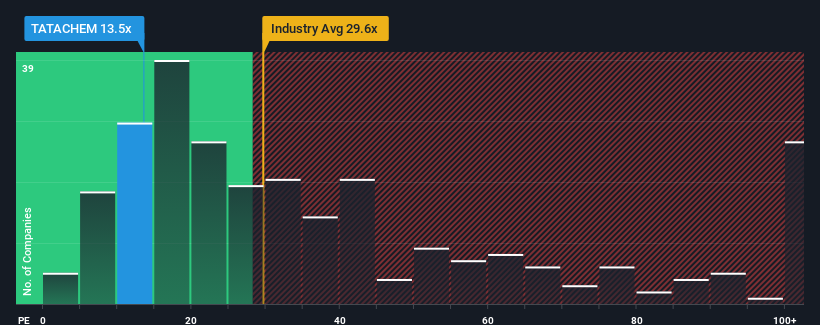Earnings Working Against Tata Chemicals Limited's (NSE:TATACHEM) Share Price

Tata Chemicals Limited's (NSE:TATACHEM) price-to-earnings (or "P/E") ratio of 13.5x might make it look like a strong buy right now compared to the market in India, where around half of the companies have P/E ratios above 30x and even P/E's above 55x are quite common. However, the P/E might be quite low for a reason and it requires further investigation to determine if it's justified.
Recent times haven't been advantageous for Tata Chemicals as its earnings have been rising slower than most other companies. It seems that many are expecting the uninspiring earnings performance to persist, which has repressed the P/E. If you still like the company, you'd be hoping earnings don't get any worse and that you could pick up some stock while it's out of favour.
View our latest analysis for Tata Chemicals

How Is Tata Chemicals' Growth Trending?
There's an inherent assumption that a company should far underperform the market for P/E ratios like Tata Chemicals' to be considered reasonable.
Retrospectively, the last year delivered a decent 3.5% gain to the company's bottom line. This was backed up an excellent period prior to see EPS up by 373% in total over the last three years. Accordingly, shareholders would have probably welcomed those medium-term rates of earnings growth.
Turning to the outlook, the next three years should bring diminished returns, with earnings decreasing 6.9% each year as estimated by the seven analysts watching the company. With the market predicted to deliver 19% growth each year, that's a disappointing outcome.
In light of this, it's understandable that Tata Chemicals' P/E would sit below the majority of other companies. Nonetheless, there's no guarantee the P/E has reached a floor yet with earnings going in reverse. There's potential for the P/E to fall to even lower levels if the company doesn't improve its profitability.
The Final Word
We'd say the price-to-earnings ratio's power isn't primarily as a valuation instrument but rather to gauge current investor sentiment and future expectations.
We've established that Tata Chemicals maintains its low P/E on the weakness of its forecast for sliding earnings, as expected. At this stage investors feel the potential for an improvement in earnings isn't great enough to justify a higher P/E ratio. Unless these conditions improve, they will continue to form a barrier for the share price around these levels.
It is also worth noting that we have found 1 warning sign for Tata Chemicals that you need to take into consideration.
If these risks are making you reconsider your opinion on Tata Chemicals, explore our interactive list of high quality stocks to get an idea of what else is out there.
If you're looking to trade Tata Chemicals, open an account with the lowest-cost platform trusted by professionals, Interactive Brokers.
With clients in over 200 countries and territories, and access to 160 markets, IBKR lets you trade stocks, options, futures, forex, bonds and funds from a single integrated account.
Enjoy no hidden fees, no account minimums, and FX conversion rates as low as 0.03%, far better than what most brokers offer.
Sponsored ContentValuation is complex, but we're here to simplify it.
Discover if Tata Chemicals might be undervalued or overvalued with our detailed analysis, featuring fair value estimates, potential risks, dividends, insider trades, and its financial condition.
Access Free AnalysisHave feedback on this article? Concerned about the content? Get in touch with us directly. Alternatively, email editorial-team (at) simplywallst.com.
This article by Simply Wall St is general in nature. We provide commentary based on historical data and analyst forecasts only using an unbiased methodology and our articles are not intended to be financial advice. It does not constitute a recommendation to buy or sell any stock, and does not take account of your objectives, or your financial situation. We aim to bring you long-term focused analysis driven by fundamental data. Note that our analysis may not factor in the latest price-sensitive company announcements or qualitative material. Simply Wall St has no position in any stocks mentioned.
About NSEI:TATACHEM
Tata Chemicals
Manufactures, markets, sells, and distributes basic chemistry and specialty products in India, Europe, Africa, America, rest of Asia, and internationally.
Adequate balance sheet average dividend payer.
Similar Companies
Market Insights
Community Narratives



